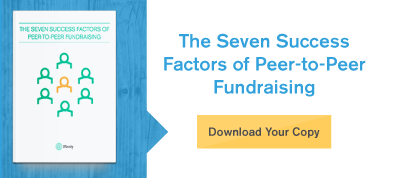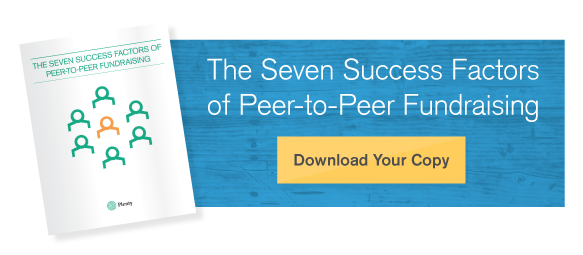Harnessing Data In Peer-to-Peer: Success Factor #6
Over the last month, we have examined the first five of our Seven Success Factors, the evaluation framework we use to help our clients optimize their peer-to-peer fundraising campaigns. These essential pieces of a peer-to-peer fundraising program include strategy, audience, ask, experience and service. The first five have long been integral components of peer-to-peer fundraising development.
However our next success factor is somewhat new to the industry. When harnessed properly, it has the greatest potential of the seven to exponentially grow a program. You may have already guessed what it is: the sixth success factor is data.
More often than not, clients tell us that they love data. Geeky has become cool, and most peer-to-peer programs have at least one person who is “crunching the numbers.” Many programs, however, are trying to track too many metrics, mistaking quantity of information for a true understanding of the program. Regularly tracking too many metrics will not help you make strategic decisions and grow your program. A key part of analytics is learning which metrics are driving results and then leaving the rest behind.
When we talk to clients about what is most critical to measure, we generally rely on the “one hand rule.” The idea is that you should only live and die by as many metrics as you can count on one hand. There might be dozens that are interesting and informative – but only a handful are most critical to any program.
Choosing which metrics to track
So how do you decide what metrics make your top five? Ask yourself the following questions:
- Does this metric directly impact the bottom line? As fundraisers, the most important measurement of our success is net revenue. Any metric that makes your top five should directly impact your bottom line. In other words, if the metric goes up or down, net revenue changes with it. While it might be interesting to know if more of your runners are choosing the 5k or the 10k route, it is most likely irrelevant to your bottom line. Stay focused on what drives net revenue.
- Do you have staff and/or resources focused on this metric? Only track metrics for program areas that are a core focus for your team. Watching metrics that you cannot influence is usually an exercise in frustration. If your department is tasked with converting leads into registrants, but the marketing department is the group that runs the social media campaign, then tracking Facebook likes is an exercise in futility. Watching results in areas you don’t control will only distract you and your team from your own top priorities.
- Is the metric based on good quality data? Ensure that you are accurately capturing the right information before you put a metric in your top five. If the data quality is poor, your results will only serve as a reminder that you don’t have enough information to make decisions. Focus instead on improving your data collection so you can track this metric next year.
Take these three questions and apply them to the metrics you are currently tracking. If you can say yes to all three, then the metric is probably worth keeping. Remember that less is more in a world of data, and that more information is only helpful if there is a strategy around it.
Our top three
So, what metrics do you consider to be part of your top five? While programs can vary wildly, here are three we always reach for:
- Number of registered constituents. This is a measure of the overall scale of the program. Whether you are operating an event, a digital campaign, a crowdsourcing effort, or a DIY program, this is where things start: The overall number of constituents participating. At this stage we aren’t concerned with whether the constituents are fundraising through their networks or not. We’re simply looking at the scale of the program. Why: This metric gives you a sense of the overall scale and thus net revenue potential of the program.
- Median donors per constituents. In peer-to-peer fundraising, we don’t just need participants – we need them to engage their networks. Median donors per constituent is a measure of how effectively our constituents are putting the peer-to-peer mechanism in motion. Note that we use median, not mean, because mean values are skewed by outliers. If we have 100 registrants, and 70 have no donors but 29 registrants have 2 donors and 1 registrant has 50 donors, the mean number of donors will be 1.08 and we can be fooled into thinking everyone is fundraising. But the median number of 0 tells us the truth: Most people haven’t started. A major focus of most of our campaign work is to grow this number above 0.
- Median amount per donation. Whereas median donors per constituent tells us how well our program is encouraging constituents to engage their networks, median amount per donation tells us how well the network is responding to the ask. Low donation values here might cause us to try better creative, use different calls-to-action, or potentially even create training tools for our constituents.
Number of constituents, median donors per constituents, and median amount per donation are three metrics we look at no matter what. But we get five, right? What do we usually do with the other two?
The answer is that most frustrating of all answers: It depends. It depends on the needs of the nonprofit, the unique circumstances of their mission and revenue needs, and the construct of the program.
At Plenty, we’re pleased that geeky has become cool – but whether it is cool or not, we’ll be using data to improve peer-to-peer fundraising. There’s a lot to be learned, so run a report, open a spreadsheet, and dive in.
Download the complete Seven Success Factors E-Book today to learn more about evaluating and improving your peer-to-peer program!
Share this
You May Also Like
These Related Stories

What's Hiding In Your Peer-to-Peer Data?

Seven Things Keeping You From Peer-to-Peer Fundraising Success




No Comments Yet
Let us know what you think